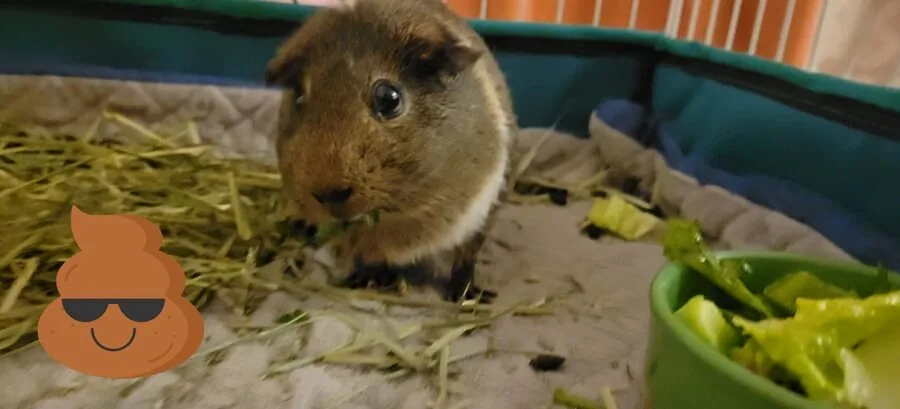Have you ever caught your adorable guinea pig munching on… well, something that doesn’t quite look like lettuce? Don’t panic! While the sight might make you cringe, it’s a perfectly normal (and even vital) part of their digestive routine.
Yes, guinea pigs eat their own poop. But it’s not just any poop – it’s a special kind called cecotropes, and it’s packed with essential nutrients they wouldn’t get anywhere else. Think of it as nature’s second course, specially made for their unique digestive system.
Types of Poop: Cecotropes vs. Regular Pellets
While the sight of your guinea pig munching on their own poop might raise an eyebrow (or two!), understanding the difference between cecotropes and regular poop is key to ensuring their well-being. These distinct types of droppings serve vastly different purposes in their digestive system.
Regular Guinea Pig Poop:
- Appearance: Small, round, and dry individual pellets, typically dark brown in color. They might have a slightly crumbly texture.
- Location: Scattered throughout their cage or litter box.
- Smell: Relatively odorless.
Cecotropes:
- Appearance: Soft, greenish-brown clusters that resemble shiny grapes or berries. They are slightly sticky and hold their shape well.
- Location: Often found clinging directly to the guinea pig’s anus or near their sleeping area. You might occasionally see them in the cage, but rarely scattered like regular poop.
- Smell: Slightly sweet and yeasty compared to regular poop.
Here’s a handy table to summarize the key differences:
| Feature | Regular Poop | Cecotropes |
|---|---|---|
| Appearance | Small, round, dry pellets | Soft, greenish-brown clusters |
| Location | Scattered in cage or litter box | Clinging to anus or near sleeping area |
| Smell | Odorless | Slightly sweet and yeasty |
Remember:
- Not all cecotropes will be perfectly green. They can range from dark green to brown depending on the guinea pig’s diet and gut bacteria.
- Don’t panic if you don’t see your piggy eating their cecotropes right away. They often consume them at night or early morning when undisturbed.
- If you find cecotropes scattered in the cage and your guinea pig isn’t eating them, consult your veterinarian to rule out any potential health issues.
By understanding the telltale signs, you can be sure your piggy is happily enjoying its nutritious cecotrope snacks. This is a vital part of their unique digestive system!
Related Article: Guinea Pig Care Guide: Must-Knows for New Owners
Cecotropes in Guinea Pigs: The Natural Recycling Process
These soft, greenish pellets may not look like gourmet cuisine. But to your guinea pig, they’re a nutritional jackpot. Here’s why:
- Second Round for Nutrients: Guinea pigs, like many herbivores, have a complex digestive system that doesn’t always absorb everything the first time around. Cecotropes are rich in vitamins B and K, fatty acids, and essential minerals. The guinea pig couldn’t fully extract them in the first pass. By eating them, they get a “second helping” of these crucial nutrients. This ensures their bodies can use them all up.
- Gut Bacteria Boost: The production of cecotropes relies on a team of specialized gut bacteria. These friendly microbes help break down food and synthesize vitamins. They also contribute to overall gut health and immune function. In short, cecotropes are a delicious snack that keeps their gut bugs happy and thriving.
- Digestive Efficiency: Eating cecotropes helps guinea pigs squeeze every last bit of nutrition out of their food. This is especially important for plant-based eaters. They rely on getting the most out of every leafy bite. It’s like maximizing their food budget with a built-in recycling program!
Guinea Pig Fecal Pellet Study by Kristin Elfers, Yvonne Armbrecht, and Gemma Mazzuoli-Weber
A group of researchers delved into the world of guinea pig poop, studying how much they eat and how much they… well, produce. By meticulously tracking the droppings of 20 furry friends, they uncovered a fascinating link between diet and output. The faster a guinea pig digests its food, the study revealed, the richer in nutrients their special “second course” becomes. These nutrient-packed poop nuggets, called cecotropes, are no afterthought. They’re essential for recycling key vitamins and minerals. They maximize the guinea pigs’ dietary bang for their buck.
But it’s not just about speed. The study also hinted at subtle digestive differences between male and female guinea pigs. This suggests that tailored diets might be ideal. Whether your piggie eats quickly or slowly, a balanced diet is key to healthy digestion and bountiful cecotropes. This diet should include hay and veggies. This helps your guinea pig thrive, one fascinating poop nugget at a time.
Concerns About Guinea Pig Eating Their Poop
While most healthy guinea pigs will readily consume their cecotropes, there might be a few reasons why I haven’t witnessed Luna indulging in this “poop-snack.”
- Diet: A healthy diet rich in hay and fresh vegetables is key for proper cecotrope production. If your guinea pig isn’t getting enough of these, they might not have as many to eat. So, keep those hay bowls topped up and provide a variety of leafy greens and veggies!
- Stress: Changes in environment or other stressful situations can sometimes disrupt their digestive habits, including cecotrope consumption. Ensure your piggy has a calm and familiar space with plenty of hiding spots to feel secure.
- Health Issues: If your cavy isn’t feeling well, they might not be able to eat or digest their cecotropes properly. If you notice any changes in their appetite, poop, or overall behavior, consulting your veterinarian is always a good idea.
Promoting Healthy Poop-Eating Habits in Guinea Pigs
As a loving guinea pig owner, you can support piggies’ natural poop-eating habits by:
- Balanced Diet: Make sure Luna has unlimited access to fresh hay and plenty of daily veggies like romaine lettuce, carrots, and bell peppers. These nutritious options will fuel her gut bacteria and keep the cecotropes flowing.
- Minimize Stress: Provide Luna with a stable routine, avoid loud noises and sudden changes, and offer plenty of hiding spots and playtime to keep her feeling secure and happy. A stress-free environment contributes to a healthy gut and regular cecotrope consumption.
- Keep an Eye on Poop: While you don’t need to become a poop connoisseur, keeping an eye on the general size, consistency, and frequency of Luna’s output is helpful. Any significant changes could indicate dietary imbalances or potential health issues, so consult your vet if you notice anything concerning.
Eating cecotropes is a perfectly natural and essential part of a healthy guinea pig’s life. It might seem strange to us, but it’s their way of staying healthy. They’re maximizing their nutrition from their plant-based diet.
Cecotrope Nutrition: What’s Inside Guinea Pig Poop
Regular guinea pig poop might not be much to write home about. However, cecotropes are like nature’s multivitamins for these herbivores. Here’s a glimpse into their nutritional treasure trove:
- Vitamin B Bonanza: B vitamins are crucial for energy production, nervous system function, and healthy skin and coat. Cecotropes are bursting with vitamins B1, B2, B6, and B12, ensuring your guinea pig stays energized, sharp, and looking their best.
- Vitamin K Champion: This vitamin plays a vital role in blood clotting and bone health. Cecotropes are a rich source of vitamin K, helping Luna maintain strong bones and prevent excessive bleeding.
- Fatty Acid Feast: Don’t worry, these aren’t the unhealthy kind! Cecotropes contain essential fatty acids that are important for cell function, immune system support, and keeping that beautiful guinea pig fur silky smooth.
- Mineral Magic: These tiny pellets are also packed with essential minerals like calcium, phosphorus, and magnesium. These minerals are vital for strong teeth and bones, proper nerve function, and overall cell health.
By eating cecotropes, your guinea pig essentially recycles these valuable vitamins and nutrients, maximizing their dietary intake and ensuring their body has everything it needs to thrive. It’s like their personal, built-in supplement system!
Gut Health Connection to Guinea Pig Cecotropes
But cecotropes are more than just a vitamin and mineral buffet. They also play a crucial role in maintaining a healthy gut microbiome:
- Gut Bacteria Playground: The production of cecotropes relies on a team of helpful gut bacteria. Eating them provides these bacteria with essential nutrients, which helps them thrive and keep Luna’s digestive system running smoothly.
- Immunity Boost: A healthy gut microbiome is closely linked to a strong immune system. By promoting gut health, cecotropes help Luna fight off infections and stay healthy from the inside out.
- Dental Hygiene Bonus: Eating cecotropes helps naturally wear down your guinea pig’s teeth, preventing overgrown incisors and painful dental issues. It’s like their built-in toothbrush made of… well, you get the idea!
So, as you can see, cecotropes are much more than just “second-hand poop.” They’re a vital part of your guinea pig’s health, promoting nutrition, gut health, and even dental hygiene. It’s truly a remarkable example of nature’s efficiency and ingenuity!
Related Article: How Often Do Guinea Pigs Pee? (Ultimate Guide)
Final Thoughts
By now, you’re hopefully convinced that cecotropes are more than just a quirky habit. They’re a cornerstone of your guinea pig’s health and well-being. Provide Luna with a balanced diet. Minimize her stress. Keep an eye on her poop, in a non-obsessive way, of course! This will support Luna’s natural cecotrope consumption and ensure she thrives.
Remember, watching your guinea pig enjoy this peculiar snack isn’t just “gross.” It’s a testament to their incredible digestive system. It’s also a reminder of the wonder and complexity of nature. So, the next time you see your guinea eating poop, smile and know you’re witnessing a fascinating piece of the animal kingdom!

